
|

|
Knattleikr, the Viking Ball Game
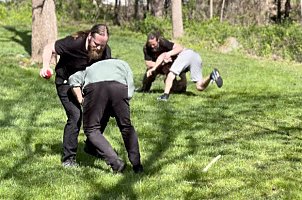 |
2023 Update We recently revisited our research on knattleikr, the Viking ball game, partially as a result of our interview in Vulture magazine on knattleikr as the game was depicted in the movie The Northman. We realized that some of our assumptions about the game were incorrect, and we now have evidence that the gameplay, the nature of the game, and indeed, the purpose of the game were all very different from what we had concluded based on our earlier research. We tested our new ideas about the game at the Hurstwic 2023 Viking feast (left and right), and we feel our research is now more on target. Further research and testing is needed, but until that work is more complete, we leave here our earlier article. Much of the evidence presented here still stands, but based on new evidence, our conclusions are much different. We hope to publish that new research soon. |
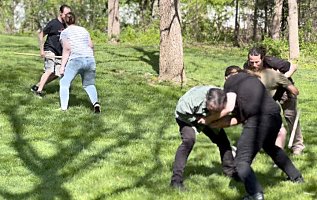 |
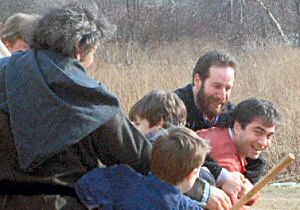 During
several of our recent feasts, we have attempted to recreate the Viking era
ball game
called knattleikr. While the game is mentioned in the stories, (such as the
Icelandic family sagas), the sources are silent about the details of the game.
No examples of the playing equipment are known to survive. No listing of the
rules has survived. In the stories, usually all that's mentioned is the fact
that people played the game, that players had disputes, and frequently, that
blood was spilled.
During
several of our recent feasts, we have attempted to recreate the Viking era
ball game
called knattleikr. While the game is mentioned in the stories, (such as the
Icelandic family sagas), the sources are silent about the details of the game.
No examples of the playing equipment are known to survive. No listing of the
rules has survived. In the stories, usually all that's mentioned is the fact
that people played the game, that players had disputes, and frequently, that
blood was spilled.
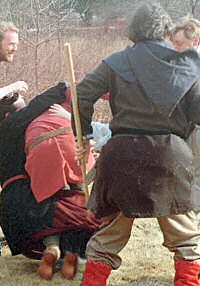 Since no hard information survives about the game, any attempt
to recreate it is pure conjecture. Some authors have compared the game to
various modern games, including hockey, rugby, lacrosse, and cricket, all of which seem very different
from one another.
Since no hard information survives about the game, any attempt
to recreate it is pure conjecture. Some authors have compared the game to
various modern games, including hockey, rugby, lacrosse, and cricket, all of which seem very different
from one another.
|
Manuscripts from after the Viking age suggest that ball games were played and illustrate the play (left). But there are no details about the rules, and nothing suggests that these games derive from knattleikr. We decided to start with the existing sources, the Sagas of Icelanders, and to try to recreate something that matched the descriptions in the sagas as best we could. We surprised ourselves with how enjoyable the game turned out to be, and we are pleased to present our conjectures for the benefit of other Viking age re-enactors who might want to give it a try. Please note our disclaimer at the top of the article: our recent research has suggested a very different form of gameplay for knattleikr than is described in this article, based on our earlier research. |
The Sources
The most complete descriptions of the game in the sagas are: Grettis saga (Gr.s.) chapter 15; Gísla saga (G.s.) chapters 15 and 18; Egils saga (E.s.) chapter 40, and Eyrbyggja saga (Ey.s.) chapter 43. From these sources, we conclude:
The bat was such that it could broken in anger, and that it could be mended on the spot (G.s. ch18). The word used in the stories is tré, meaning tree, but used for many wooden objects. However, in one instance (Gr.s. ch15), the word used is knattgildra, which has the sense of "ball catch" or "ball trap". Perhaps the bat had some element or elements that allowed it to catch or hold or carry the ball.
The ball was hard enough that when thrown in anger at another player, it could cause a bleeding injury (Gr.s. ch15). And if thrown with enough force, it could knock over another player (G.s. ch15). Loose balls bounced a long way over the ice (Gr.s. ch15).
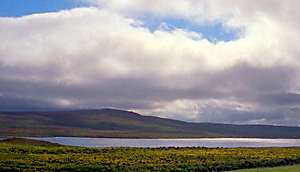 |
The playing field was usually near a pond. (The pond where Grettir played is shown to the left as it appears today.) Some modern scholars have suggested that the game was played on the surface of a frozen pond. Ice certainly figures prominently in the stories (G.s. ch18, Gr.s. ch15). Gull-Þóris saga (chapter 2) specifically states the game was played on the ice at Berufjörður (á Berufjarðarísi), and Þórðar saga hreðu (ch.3) says that games were played on the ice at Miðfjörður (á Miðfjarðarísi) between the farms of Reykir and Óss because the fjord froze easily there. (That location might be more accurately described as the estuary where the river meets the fjord.) |
| The people of Dýrafjörður played knattleikr at Seftjörn (G.s. ch15), the small pond next to the fjord shown to the right. (In Gísli's time, the pond was probably larger, since the weeds filling in the pond would have been harvested regularly.) However, the game was played in summer, when it is unlikely the pond was frozen. |
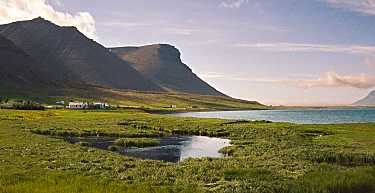 |
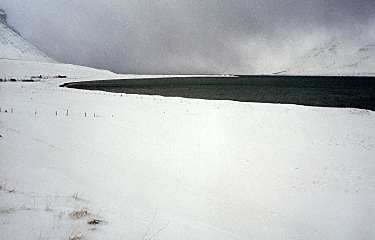 |
Later in the saga (G.s. ch18), games were held at Seftjörn in the winter. Þorsteinn brought Börkur down on the ice. However, the "ice" is actually svell, a word that implies uneven or lumpy ice and is usually applied to ice that has formed on land, rather than over a body of water. In this winter photo of Seftjörn, the pond lays buried beneath the snow in the foreground. The body of water is Dýrafjörður, located behind the snow covered pond. It's unlikely any kind of game was played on a pond as snowy as this one. |
|
The Breiðavík people played (Ey.s. ch43) below the mountain Öxl, south of the farm Knörr, shown to the right as it appears today. |
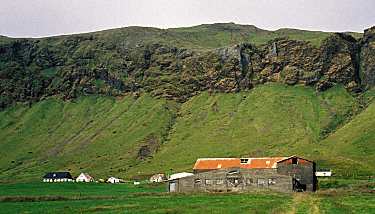 |
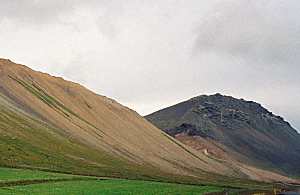 |
Egill, a slave, was given instructions to go to the games festival and kill one of the Breiðavík men. Egill waited in the mountain pass (left) above the games field where he could see the activities at the festival. When the cooking fires were lit, and smoke obscured the pass, Egill went down to cooking sheds to complete his assignment. However, before he could kill anyone, he tripped over his shoelace and was captured. The next morning, he was led back to the mountain pass and killed there. |
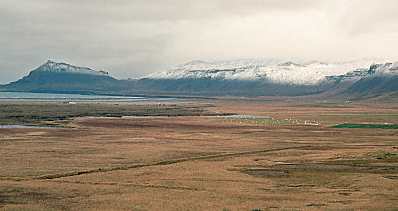 |
From his hiding place in the pass, Egill had an excellent view of the games field south of Knörr (right). Several ponds exist there today where the game could have been played. However, the games festival was held on Winter Nights (veturnætur), the beginning of the winter in the Norse calendar. This was a time for sacrifices, game festivals, and weddings, and it occurred in mid-October. In October, the mean temperature in that part of Iceland is above freezing, so it seems unlikely that ice had formed on the ponds. The photo to the left shows the likely location of the game fields near Knörr on a recent Winter Nights. While the surrounding mountains are freshly dusted with snow, the playing fields show no signs of ice or snow. |
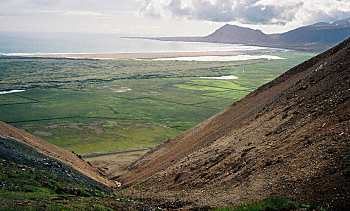 |
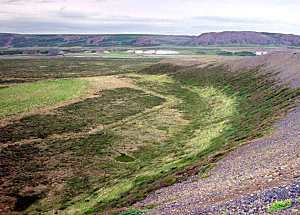 |
In chapter 4 of Vopnfirðinga saga, it is said that games were played here at Hagi (left) in Vopnafjörður in the winter. Other than the Hofsá river barely visible in the distance, there don't seem to be any bodies of water that would freeze to create a playing surface for the game. Yet the slopes that surround three sides of the playing field would have provided excellent seating for the spectators. |
| In another case (E.s. ch40), it is said that knattleikr was played on the flatland Hvítárvellir (right) adjacent to the river Hvítá. Although the game was played in winter, ice is not mentioned in the story. |
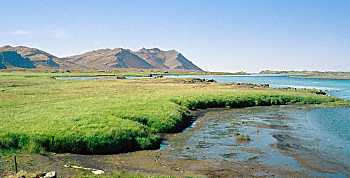 |
The games were regional (E.s. ch 40), so it seems likely that players from several dozen or even many dozens of farms participated. That implies several dozen players might be on the field simultaneously (rather than hundreds, or a small handful).
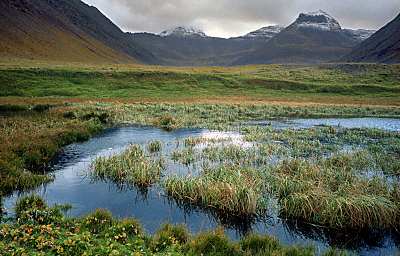 |
The games were viewed by many spectators (G.s.ch18). The women spectators sat on the slope just behind the pond Seftjörn seen in the photo to the left (G.s.ch18). |
Games could last for days (Ey.s. ch.43), although one day games are also mentioned (Gr.s. ch15).
Players were divided into two teams (Gr.s. ch15). English translations suggest that players were lined up with opposing players facing each other, although I wonder if that's reading more information into the original than is really there ("Síðan var skipað mönnum til leiks.", Gr.s. ch15). There is the sense that certain players on one side played against certain other players on the opposing team (G.s. ch18, E.s. ch40). Players were matched on the basis of strength (Ey.s. ch.43, G.s. ch18).
The play involved hitting the ball, catching the ball, and running with the ball while opposing players chased the runner (Gr.s. ch15). When the ball was hit, it traveled through the air, rather than on the ground (Gr.s. ch15). Players were held and tackled while the ball was in play (G.s. ch15). During the game, the ball could go out of play (G.s. ch15).
Our conjectures
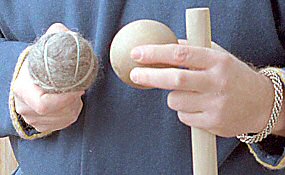 |
Almost certainly, the bat was made from wood. We used modern hardwood dowels (right), 1 to 1.5in in diameter (2.5 to 4cm) and 4ft long (120cm). Not only were they well suited for hitting the ball, but very useful for tripping and checking an opposing player. However, there was nothing about them that would allow them to trap a ball, as suggested in Gr.s. ch15. A bat similar to a modern cricket bat or a hurley stick has been suggested, but it seems unlikely that a either could be broken in anger and mended on the spot, as described in the stories. A smaller version of a cricket bat might work. It has been suggested that a shepherd's staff was used as a bat, as was commonly done in later medieval games. I am unconvinced for several reasons, including the fact that different words are used in the sagas for those two items (tré vs. stafr) The saga description suggests a hard ball, perhaps made from wood or hard leather. We tried both a wooden ball and a wool felt ball (left), as well as a modern hurling ball, called a sliotar. |
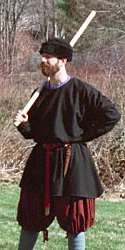 |
Before the game, we tried the wooden ball with limited success; the bat didn't connect with the ball well enough to hit it any distance. Subsequent batting practice after the game showed that it was possible to hit a wooden ball the length of the field with the bats we used. However, I would be reluctant to catch a wooden ball hit with that speed. For most of the game, we used the wool felt ball, although it's hard to believe that a felt ball could be thrown with enough force to knock someone over.
For those who don't mind using more modern equipment, I'd suggest trying a tennis ball, or a slightly larger ball, such as a child's hard sponge rubber play ball.
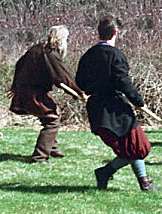 |
We originally used two teams of six players, since we had prepared only twelve bats for playing. Subsequently, we've had more players on the field during our games. Our playing field was near a pond, but we played on an adjacent grassy field. I remain unconvinced that the game was played on ice. The saga evidence is inconsistent, and the thought of playing on ice is unappealing to anyone who has worn medieval turnshoes in winter. They're very slippery on smooth surfaces like ice. (It has been suggested that the bottoms of the shoes were tarred then dipped in sand in order to provide traction on ice, but I know of no evidence to support this suggestion.) The approximate size of our playing field was a rectangle 40 by 15 paces, although larger teams would have required a larger field. While the ends of the field were well defined for scoring, the sides were only loosely defined (on one side, by spectators, and on the other by a wet, muddy area too slippery to play on while wearing medieval turnshoes). |
|
Our rules of play Two opposing teams face each other in lines. Each player has a bat. One ball is used. Each play begins with one team in possession of the ball. One member of that team throws the ball at the opposing team. Using their bats, the opposing team tries to hit the ball back to the first team before the ball touches the ground. If the ball is hit successfully, both teams attempt to take possession of the ball. The team that takes possession of the ball attempts to carry the ball down the field, through the opposing team, to the end of the field to score. The ball may be passed from one player to another. The opposing team may obstruct the player with the ball by tackling, tripping, or other means, using arms, legs, bats, or whatever may be at hand. The ball remains in play even if dropped, stolen, or intercepted, so if the opposing team captures the ball, they are free to run it to their end of the field and score. |
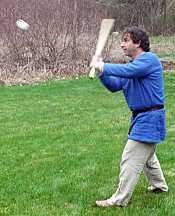 |
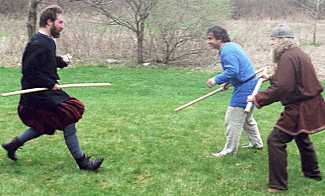 |
Play stops only when: a score is made; or the ball goes out of bounds; or the player possessing the ball is so thoroughly smothered by opposing players that he has no options for further play. If when the ball is first thrown, the opposing team fails to hit the ball before it touches the ground, or if they hit it out of bounds, play stops and the ball is returned to the first team to start a new play. |
|
If the ball is in play and goes out of bounds, possession of the ball is taken from the team that last touched the ball, and given to the other team to start a new play. If the ball is in play, and the team possessing the ball fails to score, the ball is given to the other team to start a new play. The team who has scored the most number of times when the game ends is declared the winner. The game ends when only one player remains standing, or when all the ale has been consumed. |
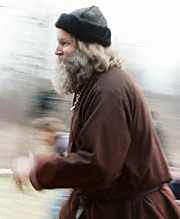 |
Some final thoughts
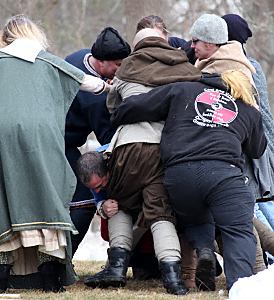 |
The game was enjoyable and challenging on several levels. It provided great entertainment for spectators. In addition, it matched the play described in the sagas on several key points. It scarcely needs mentioning that the game is dangerous, and opportunity abounds for serious injury, especially while chasing and tackling people holding bats. We remind potential players about the law in Grágás, the medieval Icelandic lawbook, which states that a man may leave a game at any time he pleases, thus he himself is responsible for any unintentional injuries he may suffer. |
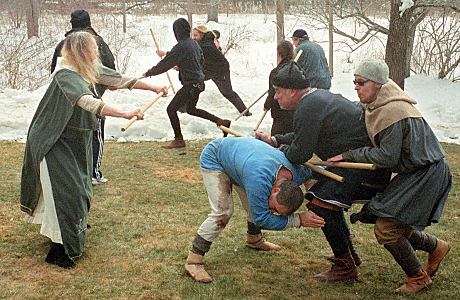 |
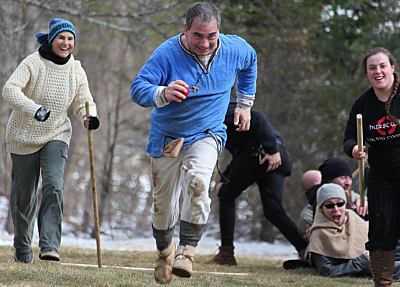 |
We would very much like to correspond with other people who have played knattleikr. We'd like to know what variations you've tried, and what worked or didn't work. Any tips or suggestions would be gratefully received. Please feel free to e-mail me. |
Some updates
We've used these rules and equipment at several of our feasts, and we continue to find the game extremely enjoyable.
|
Students at a local university have started playing knattleikr on a regular, organized basis using these rules. |
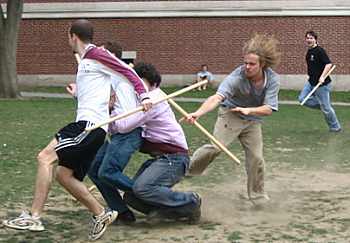
photo ©2006 Alexis Close |
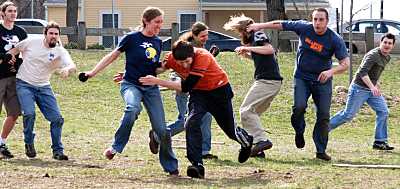
photo ©2007 Siân Gaetano |
The first annual New England intercollegiate knattleikr competition (left) was held in April, 2007. A short video clip of a practice scrimmage by the Clark University team is available here in QuickTime (9MB) or Windows Media (7MB). |
|
The sagas tell of sveinaleikr, a ball and bat game for children (Egils saga chapter 40). It's not clear how that game differed from the game for adults. The stories say it could be just as bloody. Although children greatly enjoy playing knattleikr using the rules we devised, it is a rough game, and caution is advised. The game can be made slightly safer for children by requiring that the bats be dropped once the ball is in play. Even that modification was not sufficient for one of our younger players (right), although I think it was exhaustion, rather than injury, that caused him to fall. |
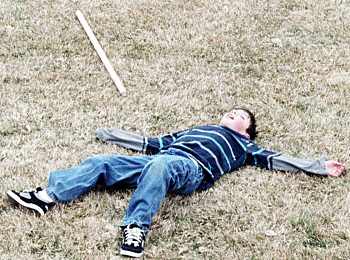 |
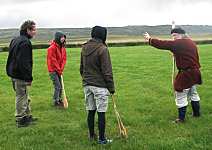 |
More recently, knattleikr was played at Víkingadagur (Viking Day) held by Minjasafn Austurlands in east Iceland. We started a game of knattleikr for adults, using the rules outlined on this page (left, explaining the rules). The game was very well received by the adults, who played vigorously. |
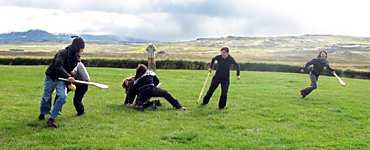 |
|
The children seemed hesitant to join in the game, perhaps because it was too vigorous. So we set up a game of sveinaleikr for them, which ended up being no less rough and tumble (right, a pileup). A great time was had by both young and old. (photos courtesy of Minjasafn Austurlands, used with permission) |
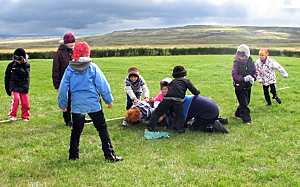 |
Other conjectures
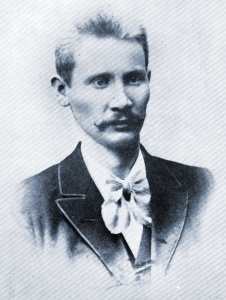 |
About a century before me, the Icelandic scholar Dr. Björn Bjarnason (left) took a similar approach to reconstruct knattleikr. Only recently did I learn of his research and book, Íþróttir fornmanna á norðurlöndum, first published in 1908. While there are similarities, his conclusions differ from mine in significant ways. Björn believed that the game was played on a marked field, and that opposing players were matched in pairs. There was one ball and one bat, and the man that started the game carried the bat and could be called the defender. During the game, men could strike at the ball, grab the ball, throw the ball, or carry the ball, and opposing players chased after it in a run. Since wrestling and scuffles often played a role in the game, the strongest players were considered the best players. A win occurred when the ball was brought over the line of the opponents. To my knowledge, Björn did not test his ideas with any physical gameplay. |
|
|
©2004-2025 William R. Short |
A Postscript
|
Egils saga (ch 40) says that young Egill (age 12) played knattleikr at Sandvík. Today, Sandvík (right) is a residential district in Borgarnes. When I visited, I saw many children playing, riding bicycles, and skating on in-line skates, but I did not see a single game of knattleikr in progress. |
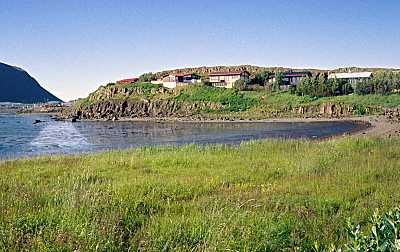 |